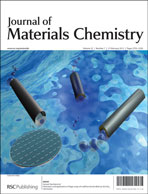Poly(amide-co-imide)/poly(trimellitic anhydride chloride-co-4,4′-methylene dianiline), PAI/PTACM blends were prepared with solution mixing and nanofiber webs were formed by electrospinning with various blending ratios. The properties of these blends were investigated using a rotational rheometer (AR2000), scanning electron microscopy (SEM), differential scanning calorimetry (DSC), and thermogravimetric analysis (TGA). The shear viscosity of the PAI/PTACM blending solution was found to be decreased upon increasing the PTACM resin content as the PTACM resin acts as a lubricating agent. With higher PTACM resin content, along with the reduction in the diameter of the PAI/PTACM blend nanofibers, the bead-on-string phenomenon was observed due to the much lower viscosity and molecular weight of PTACM resin. As the PAI resin content increased, dripping was observed during electrospinning and the diameter of the nanofibers increased significantly. PTACM resin played an important role in determining the morphology and electrospinnability of nanofiber webs, and a close relationship was found to exist between the viscosity of the blended solutions and the diameter of the blended nanofiber webs. Nanofiber webs with the most uniform diameter were obtained when the blending solution contained an equal weight ratio between the PAI and PTACM resins. The surface of these nanofiber webs with the most uniform diameter was treated with palladium (Pd(II)) ink followed by copper (Cu) plating which is applicable for printable electronic devices.

You have access to this article
 Please wait while we load your content...
Something went wrong. Try again?
Please wait while we load your content...
Something went wrong. Try again?


 Please wait while we load your content...
Please wait while we load your content...